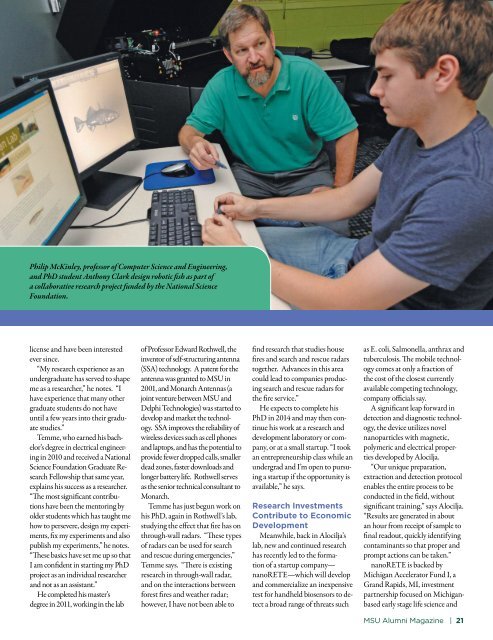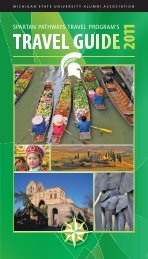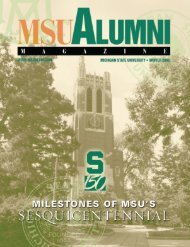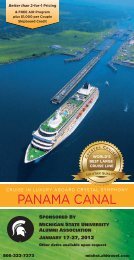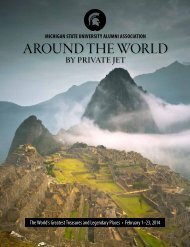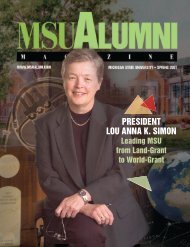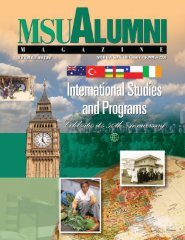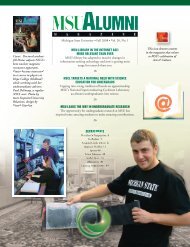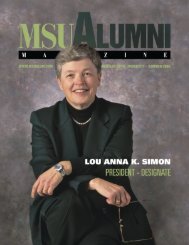Raving fans wear Spartan jewelry - MSU Alumni Association ...
Raving fans wear Spartan jewelry - MSU Alumni Association ...
Raving fans wear Spartan jewelry - MSU Alumni Association ...
You also want an ePaper? Increase the reach of your titles
YUMPU automatically turns print PDFs into web optimized ePapers that Google loves.
Philip McKinley, professor of Computer Science and Engineering,<br />
and PhD student Anthony Clark design robotic fish as part of<br />
a collaborative research project funded by the National Science<br />
Foundation.<br />
license and have been interested<br />
ever since.<br />
“My research experience as an<br />
undergraduate has served to shape<br />
me as a researcher,” he notes. “I<br />
have experience that many other<br />
graduate students do not have<br />
until a few years into their graduate<br />
studies.”<br />
Temme, who earned his bachelor’s<br />
degree in electrical engineering<br />
in 2010 and received a National<br />
Science Foundation Graduate Research<br />
Fellowship that same year,<br />
explains his success as a researcher.<br />
“The most significant contributions<br />
have been the mentoring by<br />
older students which has taught me<br />
how to persevere, design my experiments,<br />
fix my experiments and also<br />
publish my experiments,” he notes.<br />
“These basics have set me up so that<br />
I am confident in starting my PhD<br />
project as an individual researcher<br />
and not as an assistant.”<br />
He completed his master’s<br />
degree in 2011, working in the lab<br />
of Professor Edward Rothwell, the<br />
inventor of self-structuring antenna<br />
(SSA) technology. A patent for the<br />
antenna was granted to <strong>MSU</strong> in<br />
2001, and Monarch Antennas (a<br />
joint venture between <strong>MSU</strong> and<br />
Delphi Technologies) was started to<br />
develop and market the technology.<br />
SSA improves the reliability of<br />
wireless devices such as cell phones<br />
and laptops, and has the potential to<br />
provide fewer dropped calls, smaller<br />
dead zones, faster downloads and<br />
longer battery life. Rothwell serves<br />
as the senior technical consultant to<br />
Monarch.<br />
Temme has just begun work on<br />
his PhD, again in Rothwell’s lab,<br />
studying the effect that fire has on<br />
through-wall radars. “These types<br />
of radars can be used for search<br />
and rescue during emergencies,”<br />
Temme says. “There is existing<br />
research in through-wall radar,<br />
and on the interactions between<br />
forest fires and weather radar;<br />
however, I have not been able to<br />
find research that studies house<br />
fires and search and rescue radars<br />
together. Advances in this area<br />
could lead to companies producing<br />
search and rescue radars for<br />
the fire service.”<br />
He expects to complete his<br />
PhD in 2014 and may then continue<br />
his work at a research and<br />
development laboratory or company,<br />
or at a small startup. “I took<br />
an entrepreneurship class while an<br />
undergrad and I’m open to pursuing<br />
a startup if the opportunity is<br />
available,” he says.<br />
Research Investments<br />
Contribute to Economic<br />
Development<br />
Meanwhile, back in Alocilja’s<br />
lab, new and continued research<br />
has recently led to the formation<br />
of a startup company—<br />
nanoRETE—which will develop<br />
and commercialize an inexpensive<br />
test for handheld biosensors to detect<br />
a broad range of threats such<br />
as E. coli, Salmonella, anthrax and<br />
tuberculosis. The mobile technology<br />
comes at only a fraction of<br />
the cost of the closest currently<br />
available competing technology,<br />
company officials say.<br />
A significant leap forward in<br />
detection and diagnostic technology,<br />
the device utilizes novel<br />
nanoparticles with magnetic,<br />
polymeric and electrical properties<br />
developed by Alocilja.<br />
“Our unique preparation,<br />
extraction and detection protocol<br />
enables the entire process to be<br />
conducted in the field, without<br />
significant training,” says Alocilja.<br />
“Results are generated in about<br />
an hour from receipt of sample to<br />
final readout, quickly identifying<br />
contaminants so that proper and<br />
prompt actions can be taken.”<br />
nanoRETE is backed by<br />
Michigan Accelerator Fund I, a<br />
Grand Rapids, MI, investment<br />
partnership focused on Michiganbased<br />
early stage life science and<br />
<strong>MSU</strong> <strong>Alumni</strong> Magazine | 21


